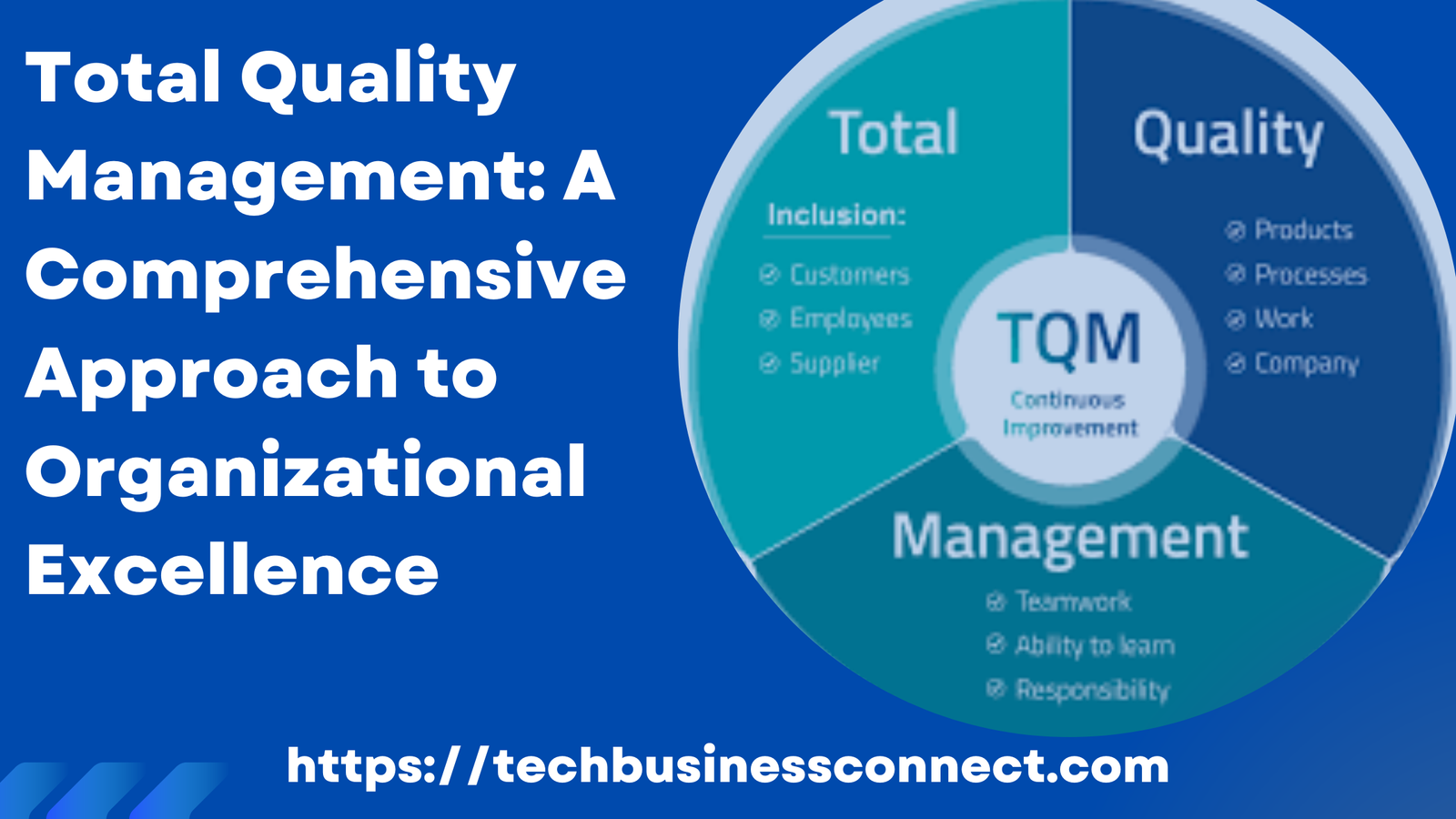
Total Quality Management Defined: A Comprehensive Approach to Organizational Excellence 2024
Total Quality Management Defined (TQM) is a holistic management approach focused on continuous improvement in every aspect of an organization’s processes, products, and services, with the goal of enhancing customer satisfaction and business performance. TQM emphasizes the importance of a quality-oriented culture, teamwork, and systematic methodologies for problem-solving, all aimed at achieving long-term success through customer delight and operational excellence.
In this article, we will explore the origins of TQM, its key principles, benefits, challenges, and the practical implementation of this strategy in organizations across industries.
Origins of Total Quality Management Defined
The roots of Total Quality Management Defined can be traced back to the early 20th century, evolving from concepts like quality control and quality assurance. However, the modern foundations of TQM were developed in Japan after World War II, where experts like W. Edwards Deming and Joseph M. Juran played critical roles in shaping the philosophy of continuous improvement (Kaizen) and quality-driven management.
Deming, widely regarded as one of the foremost proponents of Total Quality Management Defined, emphasized the importance of statistical methods for quality control and the necessity of management commitment to continuous improvement. His “14 Points for Management” provided a framework for organizations to focus on long-term quality improvement rather than short-term financial gains. Juran, on the other hand, introduced the concept of “quality trilogy” – quality planning, quality control, and quality improvement, advocating that quality is the responsibility of every employee in the organization.
The principles of TQM soon spread from Japan to the rest of the world and became integral to business management, especially in manufacturing, healthcare, and service sectors.
Total Quality Management Defined
At its core, Total Quality Management Defined is about embedding quality in every process, product, and decision within an organization. It is a continuous, organization-wide effort to improve every facet of operations to meet and exceed customer expectations. TQM is not a single strategy or tool but a comprehensive philosophy that encompasses several principles and practices to ensure that quality is maintained at all levels.
A few key elements that define TQM include:
- Customer Focus: The primary goal of TQM is to meet or exceed customer expectations. This customer-centric approach ensures that businesses not only provide quality products or services but also enhance the overall customer experience.
- Continuous Improvement: TQM emphasizes continuous, incremental improvements over time. This principle, known as “Kaizen,” encourages organizations to always look for ways to improve processes, products, and services, no matter how small the improvement may seem.
- Employee Involvement: In a TQM-driven organization, every employee plays a crucial role in the quality improvement process. From top management to frontline workers, everyone is encouraged to contribute ideas, participate in problem-solving, and take ownership of quality.
- Process-Oriented Approach: TQM emphasizes the importance of process management. By focusing on improving processes, organizations can achieve higher efficiency, consistency, and quality in their outputs. Processes are optimized to reduce waste, eliminate defects, and streamline workflows.
- Fact-Based Decision Making: Data-driven decision-making is a cornerstone of TQM. Organizations rely on quantitative and qualitative data to identify problems, track progress, and measure outcomes. Statistical methods and quality control tools such as Pareto charts, histograms, and control charts are often used to support this approach.
- Integrated System: TQM promotes the idea of viewing an organization as an integrated system. This means that different departments, teams, and processes must work together in harmony to achieve the overall goal of quality improvement. Silos are broken down, and cross-functional collaboration is encouraged.
- Supplier Partnerships: In TQM, the relationship with suppliers is also critical to ensuring quality. By fostering close collaboration with suppliers, organizations can ensure that raw materials and components meet the necessary quality standards, contributing to the overall excellence of the end product.
- Strategic and Systematic Approach: Quality improvement is linked to the organization’s strategic goals. By aligning TQM initiatives with business objectives, companies can ensure that their efforts are not only improving quality but also driving overall business success.
Benefits of Total Quality Management
Total Quality Management Defined offers numerous benefits to organizations that implement it effectively. These benefits are not limited to quality improvement but extend to all areas of organizational performance, customer satisfaction, and financial success.
- Enhanced Customer Satisfaction: By continuously improving product and service quality, organizations can meet and exceed customer expectations, leading to higher customer satisfaction and loyalty. Satisfied customers are more likely to become repeat buyers, refer others, and contribute to the company’s long-term success.
- Improved Operational Efficiency: TQM helps organizations streamline their processes, reduce waste, and minimize defects. This not only improves product quality but also enhances operational efficiency, reducing costs and improving overall productivity.
- Better Employee Engagement: In TQM, employees are encouraged to take an active role in quality improvement efforts. This sense of ownership and involvement can lead to higher job satisfaction, motivation, and engagement among employees.
- Reduction in Costs: By focusing on quality and process improvements, organizations can reduce the costs associated with rework, defects, customer complaints, and warranty claims. TQM can also help reduce the cost of quality failures, such as production delays or product recalls.
- Competitive Advantage: Companies that implement TQM successfully gain a competitive advantage by offering superior products or services. This differentiation can lead to increased market share, improved reputation, and greater financial success.
- Increased Innovation: Continuous improvement and employee involvement in problem-solving foster a culture of innovation. TQM encourages organizations to explore new ideas, test new approaches, and implement innovative solutions to improve processes and products.
Challenges in Implementing Total Quality Management
While Total Quality Management Defined offers many benefits, its implementation is not without challenges. Organizations must navigate several obstacles to successfully integrate TQM into their culture and operations.
- Resistance to Change: One of the most significant challenges of implementing TQM is overcoming resistance to change. Employees, especially those who are accustomed to traditional management approaches, may be reluctant to adopt new processes and practices. It is essential for leadership to communicate the benefits of TQM and provide the necessary support and training to facilitate the transition.
- Lack of Management Commitment: TQM requires strong leadership commitment and involvement. If top management is not fully invested in the quality improvement efforts, it can hinder the success of the TQM initiative. Managers must lead by example and actively participate in quality improvement activities.
- Inadequate Training: TQM relies on employees being well-versed in quality improvement techniques and methodologies. Without proper training, employees may struggle to implement TQM principles effectively. Organizations must invest in continuous training and development to ensure that employees have the necessary skills and knowledge.
- Short-Term Focus: TQM is a long-term approach to quality improvement, but some organizations may be tempted to focus on short-term gains. This short-term thinking can undermine the effectiveness of TQM and prevent organizations from achieving sustained improvements.
- Cultural Barriers: In some cases, the existing organizational culture may not align with the principles of TQM. For example, a hierarchical, top-down culture may be at odds with the collaborative, team-based approach promoted by TQM. Organizations must work to shift their culture to support the values of quality and continuous improvement.
Practical Implementation of TQM
Implementing Total Quality Management Defined requires a systematic and structured approach. Here are a few steps that organizations can follow to successfully integrate TQM into their operations:
- Top Management Commitment: The first step in implementing TQM is securing top management’s commitment to the initiative. Leadership must be fully invested in the process and lead by example.
- Establishing a Quality Vision and Goals: Organizations should define their quality vision and set clear, measurable goals for quality improvement. These goals should align with the overall strategic objectives of the business.
- Employee Training and Development: Employees should be provided with the necessary training on quality improvement tools and techniques. This ensures that they have the skills and knowledge required to contribute to the TQM effort.
- Process Mapping and Analysis: Organizations should map their key processes and identify areas for improvement. Data-driven analysis can help pinpoint bottlenecks, inefficiencies, and quality issues that need to be addressed.
- Implementing Continuous Improvement Initiatives: Once improvement opportunities are identified, organizations can implement continuous improvement initiatives. This may include adopting lean manufacturing principles, reducing variation, or optimizing workflows.
- Monitoring and Measurement: Continuous monitoring of progress is essential to the success of TQM. Organizations should regularly measure key performance indicators (KPIs) to track improvements and identify areas for further optimization.
Conclusion
Total Quality Management Defined is a powerful approach to achieving long-term success through continuous improvement, customer satisfaction, and operational excellence. By embracing the principles of TQM, organizations can not only improve the quality of their products and services but also enhance employee engagement, drive innovation, and gain a competitive edge in the marketplace. Despite the challenges associated with its implementation, TQM remains one of the most effective strategies for fostering a culture of quality and achieving sustainable business growth.


